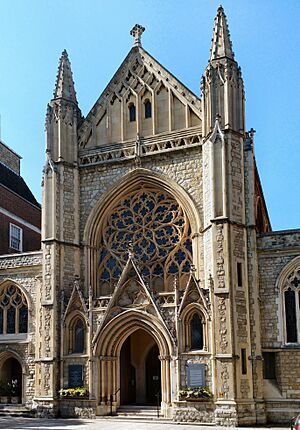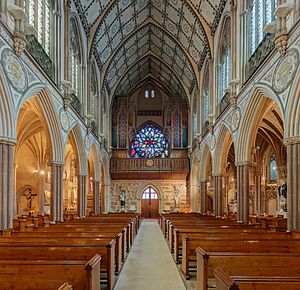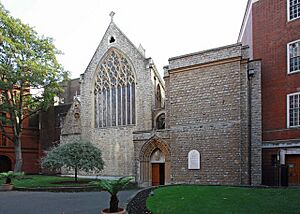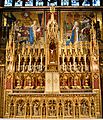Church of the Immaculate Conception, Farm Street facts for kids
Quick facts for kids Farm Street Church |
|
|---|---|
| Church of the Immaculate Conception, Farm Street |
|

Entrance to the church on Farm Street
|
|
| Lua error in Module:Location_map at line 420: attempt to index field 'wikibase' (a nil value). | |
| OS grid reference | TQ 28545 80577 |
| Location | Mayfair, London |
| Country | England |
| Denomination | Roman Catholic |
| Religious order | Society of Jesus |
| Website | farmstreet.org.uk |
| History | |
| Status | Active |
| Founded | 1849 |
| Founder(s) | Randal Lythgoe SJ |
| Dedication | Immaculate Conception of Mary |
| Consecrated | 31 July 1849 |
| Architecture | |
| Functional status | Parish church |
| Heritage designation | Grade II* |
| Designated | 24 February 1958 |
| Architect(s) | Joseph John Scoles |
| Style | Gothic Revival |
| Groundbreaking | 1844 |
| Completed | 1849 |
| Administration | |
| Deanery | Marylebone |
| Archdiocese | Westminster |
| Province | Westminster |
The Farm Street Church, also known as the Church of the Immaculate Conception, is a Catholic church in Mayfair, Central London, England. It is run by the Society of Jesus, also known as the Jesuits.
You can find its main entrance on Farm Street. There is also another way to enter from the nearby Mount Street Gardens. Sir Simon Jenkins, a famous writer, called the church "Gothic Revival at its most sumptuous." This means it is a very grand and beautiful example of the Gothic Revival style.
Contents
History of Farm Street Church
The Jesuits are a group of Catholic priests. In the 1840s, they started looking for a place to build a church in London. They found a spot on a small back street called Farm Street. This street got its name from 'Hay Hill Farm', which used to be in this area a long time ago.
Building the Church
In 1843, the Pope, who is the leader of the Catholic Church, gave permission for the Jesuits to build their church. The original plan was for a very large church that could hold 900 people. However, this was too expensive. So, they decided to build a smaller church that could fit 475 people. The cost was £5,800, which was paid for by many different people who wanted to help.
The first stone of the church was laid in 1844. Because the land was not very big, the church was built facing north-south instead of the usual east-west. The architect who designed the church was Joseph John Scoles. He also designed other churches in England. Five years later, on July 31, 1849, the church officially opened. This date is special because it is the feast day of St Ignatius, who founded the Jesuit order.
The church is built in a style called Decorated Gothic. The front of the church, which faces Farm Street, looks similar to parts of the famous Beauvais Cathedral in France. The main altar was designed by Augustus Pugin, a very well-known architect. Above the altar, there are two beautiful mosaic pictures. These pictures show the Annunciation (when an angel told Mary she would have Jesus) and the Coronation of the Virgin (when Mary was crowned Queen of Heaven).
In 1912, the original stained glass window in the choir area became dirty from pollution. It was replaced with a new one. The old window was cleaned and sent to a church in Canada.
The church was repaired and changed a bit in 1951. This was because it had been damaged during the Second World War. In 1966, it became the main parish church for the Mayfair area.
Sir Simon Jenkins wrote in his 1999 book that the church is very decorated. He said that "Not an inch of wall surface is without decoration." This means almost every part of the church has some kind of art or design. He also mentioned a beautiful modern stained glass window by Evie Hone from 1953.
Music at Farm Street Church
In the 1800s, the church choir was made up only of men and boys from local Catholic schools.
From 1881 to 1916, the church organist was John Francis Brewer. He was only 18 when he started this job. He was also a writer.
After the First World War, the choir was led by different people. A Belgian musician named Guy Weitz became the organist. He had studied with famous composers. One of his best students was Nicholas Danby. Nicholas Danby became the church organist in 1967. He helped make the choir a group of professional singers in the 1970s.
After Nicholas Danby passed away in 1997, two of his students, Martyn Parry and David Graham, became the Joint Directors of Music. Later, Duncan Aspden joined David Graham to help lead the choir and play the organ.
The church has also made recordings of its music. In 2000, a CD of organ music was recorded on the church's organ. Today, the choir performs many different types of music. This includes old music from the 1500s, classical music, and modern songs. They also sing Gregorian Chant, which is a very old style of church music.
London Jesuit Centre
In 2004, the Mount Street Jesuit Centre was started. It aimed to help adults learn more about their Christian faith. They offered courses, retreats, and helped homeless people.
In 2019, a college called Heythrop College closed down. The London Jesuit Centre was then opened in the same place. It has a reading room with about 8,000 books from the Heythrop Library. This means people can still use many of the books from the old college. The London Jesuit Centre offers courses, spiritual retreats, and supports research. It continues the work of the Mount Street Jesuit Centre.
Thinking Faith Online Journal
Thinking Faith is an online magazine. It publishes articles about faith, politics, philosophy, and culture.
Before Thinking Faith, there was a monthly magazine called The Month. It ran from 1864 until 2001. After it closed, the Jesuits wanted to continue sharing articles about faith. So, on January 18, 2008, Thinking Faith was launched. It was designed to be online and publish articles more often. It covers topics like the Bible, spirituality, and social issues. It also reviews books and films. You can read and subscribe to it for free.
Royal Visit to the Church
In 2023, for the first time, His Majesty King Charles III visited the Church of the Immaculate Conception. He attended a special Advent service. This event was co-hosted by a Catholic charity called Aid to the Church in Need (ACN), which helps Christians who are facing difficulties.
Images for kids
-
St. Francis Xavier Chapel
See also
- Ignatian spirituality
- List of Jesuit sites in the United Kingdom
- List of Catholic churches in the United Kingdom











